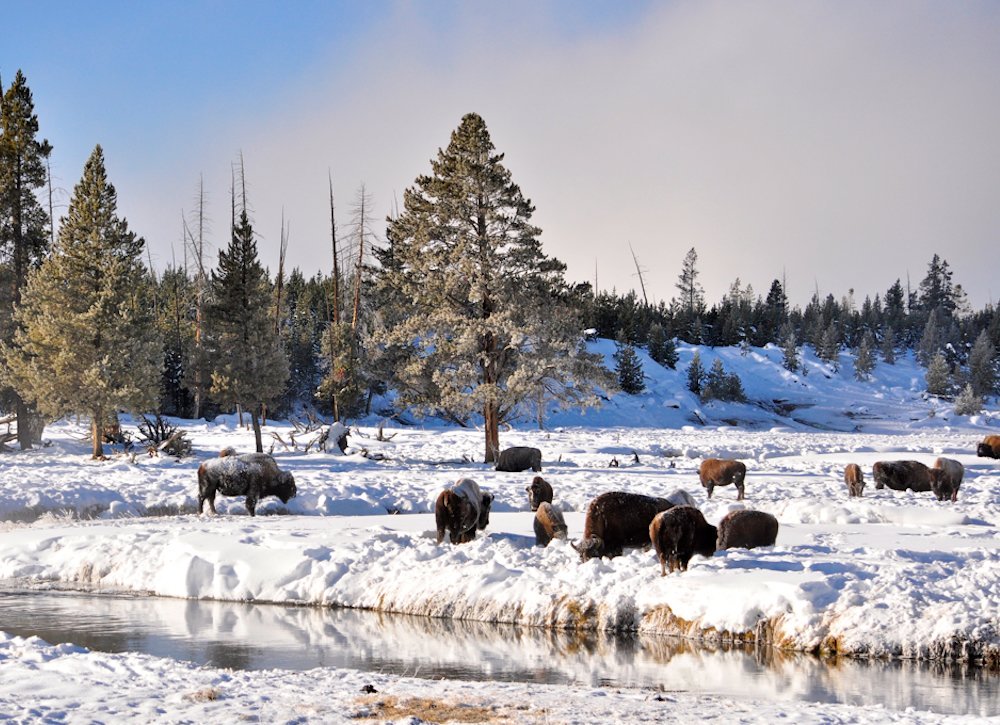
In the northwestern United States, Yellowstone National Park fills the northeast corner of Wyoming, spilling into southwest Montana and east-central Idaho. With park entrances at the north, west, south, east and northeast, access by car or bus is easy. Although only the north and northeast roads are open to vehicles in winter, visitors can enter the park via snowcoach or snowmobile from most entrances.

Fly in to Salt Lake City, Utah; Bozeman or Billings, Montana; Cody or Jackson Hole, Wyoming; or Idaho Falls, Idaho—all are a day trip to Yellowstone Park.
Visiting Yellowstone Park in Winter
From December through March, much of Yellowstone National Park’s 2.2 million acres of land is quietly covered in snow. Crowds are gone and car traffic is significantly diminished throughout the amazing landscapes of America’s first national park. Bison and elk herds roam more freely in winter, along with wolves, mountain goats, moose, mule deer and bighorn sheep.
Yellowstone’s wilderness, with elevations ranging from 5,282 to 11,358 feet, is a pristine world in winter. Its 10,000 thermal features usually stay above 100 degrees regardless of the air temperature, so they continue spewing hot water, steaming and bubbling. Winter activities in Yellowstone range from hiking, Nordic skiing and snowshoeing to snowcoach and snowmobile tours. Experience the park from bases at Old Faithful and Mammoth Hot Springs.
Old Faithful Geyser Area
Upper Geyser Basin, where the famous Old Faithful geyser is located, holds the largest number of geysers in the park—with 150 geothermal features within one square mile. Watch geysers shoot scalding water 145 feet or more in the air while the ground is covered with snow and ice. Stay at the Old Faithful Snow Lodge and Cabins with several dining options available.
Xanterra Parks & Resorts operates heated snowcoaches to Old Faithful Snow Lodge from the west (West Yellowstone) and south (Flagg Ranch) entrances to Yellowstone National Park. Snowcoach, ski and interpretive tours are available from the lodge, including a winter photo safari, day trip to the Grand Canyon of the Yellowstone, guided snowshoe or Nordic ski tours.
Mammoth Hot Springs Area
Several acres of terraced springs in shades of pink, yellow, orange, green and brown formed from limestone deposits are the main feature at Mammoth Hot Springs. The upper and lower terraces are constantly changing, as new travertine formations grow, forcing water to flow in different directions. The nearby Mammoth Hot Springs Hotel offers rooms, suites and cabins as well as dining options in an area that once served as Fort Yellowstone and now houses the park headquarters.
Snowcoaches depart from Mammoth, with interpretive tours available to Lamar Valley’s unique wildlife and Norris Geyser Basin. Xanterra’s winter getaway packages at Mammoth include cross-county ski and snowmobile touring. A guided snowmobile “trail of the wolf” tour is also offered at Mammoth.
Hands-On Exploration of Yellowstone
Explore the park by day with a naturalist guide from the Yellowstone Association, the National Park Service’s educational partner. The Lodging and Learning programs offer journeys in the park enhanced by the association’s expertise coupled with Xanterra’s Yellowstone accommodations and services.
Choose from an Old Faithful Expedition traveling to the Grand Canyon of the Yellowstone and Yellowstone Lake, searching for wildlife, thermal features and pristine winter views; a Wolf Discovery tour into Lamar Valley to learn about wolves in their natural environment; a Family Winter Holiday to learn animal tracking, wildlife watching, photography, cross-country skiing and snowshoeing; and a four-day cross-country ski adventure on Yellowstone’s numerous trails.
Yellowstone National Park offers a large variety of wildlife and the world’s most extraordinary geysers and hot springs. Visiting the park in winter affords a unique perspective of thermal features and wild animals while avoiding summer’s crowds. Experience other Western U.S. national parks, such as central California’s Yosemite and western Washington’s Olympic and Mount Rainier.

